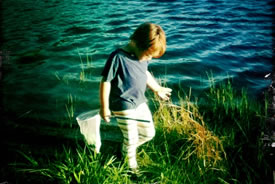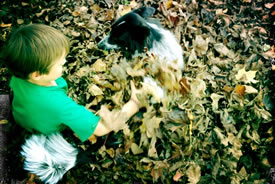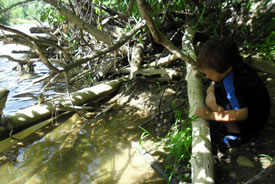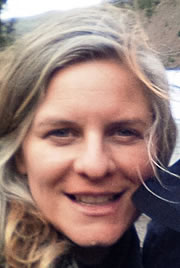With deer in cedar: A call to get children back into nature

Looking for wild things at the lake (Photo by Erica Thompson/NCC staff)
To witness a deer in full flight is astounding. It’s particularly impressive when you are standing only a few feet from its flight path.
I was walking with friends and their one-year-old son at the back of their farm on the Niagara Escarpment near Mansfield, Ontario a few days ago. We were making our way downhill, into the shaded cedar forest that leads to the Boyne River. The yearling deer bounded past us, scared up by our presence. It was so nimble. In those few seconds, it appeared to be more a creature of air than land. It was a brief moment of wonder in the cedars. None of us had ever been that close to a deer on its best move before.
In general, forests house endless opportunities for wonder. But cedar forests are special places to me all on their own. There was one behind the house where I lived in until I was seven. It was a small clump of trees but its offerings were endless. Even though the address was Hickory Street, the cedars are the ones holding tight to my memory, to my makeup.

A boy's best friend (Photo by Erica Thompson/NCC staff)
My friends and I spent countless hours building forts, unearthing treasures like snail shells and climbing up on the huge lone stone that proved the glaciers must have passed through. That was what my neighbour’s dad told us and how could I not be compelled by the idea of a giant ice sheet dragging boulders for thousands of miles before dropping one on my street? It was more than a decade later that I learned about glacial erratics, but as a young girl, I was captivated by nature’s clues to a time I couldn’t see. It was a story about my home that was way older than me and it made me curious.
But childhoods like mine are fewer and far between these days. Last month, the Royal Society for the Protection of Birds (RSPB ) released a report stating that currently only one in five children in the UK have a “level of connection to nature that can be considered ‘realistic and achievable’ for all children.” The report speaks to a growing global concern that children have diminishing connections to the natural world and that this lack of engagement isn’t good for anyone.
The impacts of this disconnect are sobering: the absence of nature in early years has been linked to a loss of emotional and physical well-being, impaired social skills, poor memory and declining academic performance, to name a few.
This lack of connection between youth and nature is not only a Pandora’s Box for our children but for the natural world itself, say the authors. While we spend less and less time in nature, the number of threatened or endangered species grows and habitat loss continues at an alarming rate. With a loss of connection comes the loss of bearing witness, of understanding, of personal motivation to respond
Personal observation and time in place play a critical role in learning. Actually seeing, smelling and feeling pine cones, millipedes, frogs and fossils for example allows children to learn on a whole different level. Learning about forests within a forest habitat, learning about wetlands by standing on the edge of one, and seeing a salamander under a log for the first time – these are the kinds of experiences that we hope inspire lifelong learning and curiosity about the natural world.

On the lookout for turtles (Photo by Erica Thompson/NCC staff)
Back on Hickory Street, under the forest's cool and lacy canopy we dreamt up games and imagined history — who had walked through this forest before us? What animals had lived there or just passed by? The odd deer bone provided hours of speculation. Even now, when I find myself wandering through a stand of cedars, like that day at the Boyne River, I feel at home in that coolness. I remember pieces of my childhood amidst the shaggy reddish brown bark, the sideways swinging trunks and moist soils. And like that deer, wondrous things still happen when I spend time outside.
Initiatives such as the RSPB’s, aimed at “putting nature back into childhood,”are burgeoning all over the world as collective response to what Richard Louv calls a “nature deficit disorder” amongst our children, amongst ourselves. In my home province, the Ontario government recently announced the Ontario Children’s Outdoor Charter in an effort to encourage discovery, play, learning and education in nature.
If the connected futures of a healthy natural world and healthy people are dependent upon an engaged citizenry with personal connections to place, how do we get there? It’s an important question to me, as my son will turn six years old next month. How will I help him find his special places, like my cedar forests? We get outside, one wonderful adventure at a time. Who knows what we will see, what we will find together.


